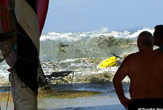Satellites Recorded the Swell before the Tsunami

Satellites flying over the Indian Ocean on Dec. 26 were able to detect in a radar image the tsunami that struck the Asian and African coastlines. This is the first time that a profile of a tsunami has been measured in the open ocean.
The data was collected by the U.S./French oceanographic satellites, Jason and TOPEX/Poseidon, during an eight minute fly-by, which occurred two hours after the magnitude 9.0 earthquake.
The leading wave front of the tsunami was found to be 500 miles (800 kilometers) long and one and a half feet (50 centimeters) high.
"In the open ocean, that's very high," said NASA Project Scientist Lee-Lueng Fu. "But people at sea can barely notice it."
This height gives some indication of the tsunami's energy. The speed of the wave front depends solely on the depth, so in the middle of the bay -- where the depth is about 2.5 miles (4,000 meters) -- the wave front was barreling along at 500 mph, Fu told LiveScience in a telephone interview.
But as the waves approach the coast, the speed decreases in the shallower waters. At a depth of 33 feet (10 meters), for instance, the speed reduces by 20 times what it was at 2.5 miles. Correspondingly, the height increases by 20 times - which, for the case of the leading wave front, would mean waves over 30 feet high.
Serendipitous Observation
The satellites that made the measurements are primarily used to study ocean currents.
Get the world’s most fascinating discoveries delivered straight to your inbox.
"We can measure a two centimeter change in height due to ocean currents," Fu said. "The tsunami was a big signal -- very easy to see."
The satellites fly side by side - separated by 93 miles (150 kilometers) - essentially taking the same data. This redundancy improves the resolution of the radar images, Fu said. Measurements of the ocean height are made every 3.6 miles (6 kilometers).
The satellites circle the Earth about 13 times a day, making tracks over the Earth that are separated by about 1,860 miles (3,000 kilometers).
"[The satellites] just happened to be flying over the Southern Ocean to the Bay of Bengal in a SW to NE direction," Fu said. "It was really very fortuitous that we caught the tsunami in the act."
Ripples on the Swell
This is the first time that scientists have a continuous picture of a tsunami wave. Before, data was confined to measurements at separate points from buoys.
Although the data coldly documents an immensely tragic event, researchers hope to gain some insight into the dynamics of tsunamis.
"We have detected ripples on the big waves -- something we have never seen before," Fu said. "Tsunami experts will be studying these -- maybe for years."
Not a Detection Method
Because the satellites only measure the height of the sea directly below their flight pattern, Fu said that they would be an inappropriate warning system. It can take one satellite several days to return to the same location, and the data currently takes at least five hours to process.
"You would need 100 satellites [for a warning system], which is just too costly," Fu said. "A better approach is to put more buoys in the ocean."
Warning buoys can be placed at a number of locations for far less money. Underwater pressure gauges measure the passing of a tsunami, since "a half meter of ocean weighs a lot," Fu explained. The gauges send a signal to a nearby surface buoy, which relays the message to a satellite.
Such buoy systems are already operational in the Pacific. Plans are in the works to put a similar system in the Indian Ocean.



